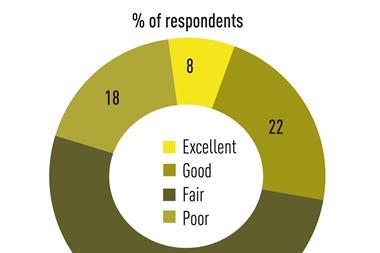Disclosures around firms’ investments into low-carbon versus fossil fuels is set to be a key theme this annual general meeting (AGM) season, according to Linda-Eling Lee, MSCI’s sustainability chief.
The Clean Energy Financing Ratio is a climate disclosure metric designed to make the proportion of fossil fuel financing versus cleaner energy more transparent.
“It points to the fact that there is now a greater emphasis on looking at how much of a portfolio’s investments are going towards the solution part of the transition – which sometimes come with large emissions,” said Lee, founding director and head of the MSCI Sustainability Institute.
”It goes beyond footprinting, and looks at the mitigation potential of your investments,” she continued.
Lee’s comments come just ahead of the peak AGM voting season in Europe and North America, which tends to take place between April and June.
Earlier this month the Comptroller for the City of New York, called on three major banks – Bank of America, Goldman Sachs, and Morgan Stanley – to disclose their annual Clean Energy Financing Ratio, which saw The Church of England Pensions Board (CEPB) recently pre-declare its intention to vote for clean energy shareholder proposals at the upcoming AGMs of all three.
According to Lee, many financial institutions first began making commitments towards backing clean energy solutions in the lead up to COP26 – which is when MSCI began publishing its Net Zero Tracker.
Now in its ninth edition, the tracker tracks the progress of publicly listed companies in the MSCI ACWI Index, which captures large and mid-cap representation across 23 developed markets and 24 emerging markets countries, and has 2,841 constituents, in keeping global warming below 2°C.
This latest edition spotlights the COP28 agreement to transition away from fossil fuels in energy systems and discusses the key role the listed utilities sector has in achieving these aims.

MSCI found that nearly 60% of listed companies are disclosing their Scope 1 and 2 emissions, an increase of 16 percentage points in two years. While also highlighting that aggregate emissions of publicly listed companies will need to peak next year and fall by roughly 7% annually between now and 2030 to avoid the worst effects of global warming.
Materiality
The tracker report come after the US Securities and Exchange Commission (SEC) enacted a long-awaited rule last month that requires for the first-time company disclosures on climate risks. While welcomed overall, some say the ruling lacks some of the more ambitious mandates included in the initial proposal two years ago.
The final version of the rule excludes Scope 3 emissions, as well as narrows Scope 1 and Scope 2 disclosures only to emissions deemed ‘material’ for larger SEC-registered businesses.
Despite this concession, the US appeals court has since halted the SEC Climate-Disclosure Rule after Liberty Energy and Nomad Proppant Services challenged its legality.
For MSCI’s Lee, however, the ruling signals that emissions and materiality do in fact go hand in hand.
Looking for IPE’s latest magazine? Read the digital edition here








































No comments yet